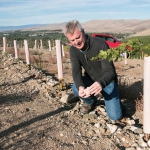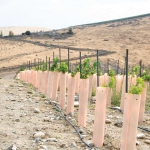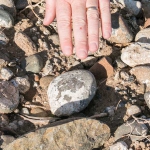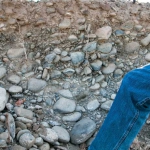When David O’Reilly was looking for vineyard property in Washington’s Yakima Valley, he had three things on his list: elevation, diverse soil types, and a warm site. He found all three, plus a bonus of breathtaking views of the valley and Cascade Mountains.
The 106-acre parcel near Union Gap fit O’Reilly’s wish list of having elevations above 1,120 feet, a mix of volcanic and loess soils, and being located in a warm site so there’s low risk of frost or winter injury.
“I don’t like growing grapes lower than 1,120 feet because the soils are more clay, which makes them colder in the summer and fall compared to shallow, rocky soils,” said the co-owner and winemaker of Owen Roe Winery.
“We purposely located the winery at the lowest elevation of the site where the clay soils are. That’s also where the cherry orchard is located and why tree fruit and wine grapes are symbiotic. Orchards grow well in deep soils and we (wine grapes) grow best in shallow ones.”
Only red wine grapes are grown at Union Gap Estate (Cabernet Sauvignon, Cabernet Franc, Syrah, Malbec, Mouvedre, and Merlot), which now totals nearly 32 acres of vines. He removed two existing blocks of white varieties and planted 15 acres last spring.
The site has three soil types—volcanic soil with basalt layers and rock at the highest elevations, glacial Ice Age deposits of silt and loess from the ancient Lake Missoula floods in the middle elevations, and gravelly loam at the bottom. O’Reilly has a different growing strategy for each soil zone and uses the zones to create different flavor profiles for blending options when making wine.
“Elevations of about 1,230 feet seem to be the edge of the reach of the glacial floods,” said O’Reilly, noting that soils above 1,230 feet are rockier than the loess, silt, and clay soils below.
At the Union Gap vineyard, there is a visible line between the old, rocky soil and loess soils that shows the reach of glacial floods. The vineyard has slopes from 15 to 30 degrees.
He planted Mouvedre, Grenache, and Syrah at the top of the vineyard where there are deep deposits of alluvial stones from a riverbed from the Ellensburg Formation, a thick layer of sediment formed ten million years ago. Mouvedre, the most vigorous of the three varieties, was planted in a tight one-by-one meter (3-by-3 feet) spacing and will be head trained and pruned, without trellis wires.
Grenache and Syrah, also aggressive varieties, were planted at spacing of two-by-two meters (6.5 feet between vines and 6.5 feet between rows).
He explained that the harsh conditions of rocky soil, wind, and heat on the top of the hill should force the vigorous varieties to slow down.
Soil of the new planting is so rocky that iron rebar had to be used instead of bamboo stakes—and most of the rebar got bent as it was pounded in.
Cabernet Sauvignon and Cabernet Franc, varieties that don’t do as well in rocky soils, were planted at slightly lower elevations where there was more soil tilth. •










Leave A Comment